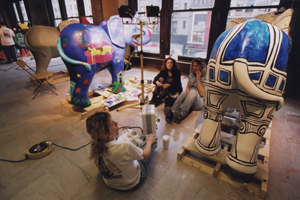The Club of Cool
From The New CriterionIt was one afternoon when I was on my way to an exhibition at the Folger Shakespeare Library called “Breaking News: Renaissance Journalism and the Birth of the Newspaper,” that I caught my first glimpse of the revolution in advertising. I saw it on the side of a Washington Metropolitan Transit Authority bus: a long, clean, pastel-blue rendering of the words “Yes You Can” with the “O” of the word “You” filled in by a version of the long-familiar, red-and-blue, yin-and-yang logo for Pepsi-Cola, now redesigned to look as much as possible like the hopeful-sunrise-on-a-ploughed-field Obama logo. There was no mention of Pepsi that I could see, but then I wasn’t looking closely at the words. I seem to remember something about deliciousness — was it? — or maybe youth and excitement in what amounted to a screen crawl at the bottom of the ad, but I didn’t bother trying to read what it said. I was already lost in a lovely reverie of empowerment.
Actually I wasn’t, of course, but my wonderment could hardly have been greater if I had been. As it happened, I had also just been reading an article in The Washington Post about the subtle change in the relationship between power and celebrity since our last celebrity president, Mr Bill Clinton. “I have noticed one key difference in our culture,” the Post had quoted Michael Levine, “a Hollywood publicist for 25 years” as saying: “Clinton basked in the glow of celebrities. Now celebrities bask in the glow of Obama. . . Somehow he has become the sun and we’re rotating in his orbit.” So that’s what the sun-like orb of the “O” is about! It should hardly be surprising, then, if advertisers, who have long exploited the commercial benefits of association with celebrities, should be trying to surf the wave of Obamania. Yet this ad struck me as being something more than that. Perhaps it was a case of the designers of the Obama presidential campaign and Pepsi both spotting the same cultural opportunity at the same time.
Except that Pepsi had spotted it first. In an interesting article in Slate last summer, James Ledbetter first tried to tease out the significance of the similarity between the old Pepsi logo and the new Obama one, as well as the fact that he was nominated in the Pepsi Center in Denver. “During the primaries,” Mr Ledbetter wrote, “some bloggers argued that Obama’s insurgent campaign made him Pepsi to Hillary’s establishment Coke. An eagle-eyed observer (who happens to work for Pepsi’s P.R. firm) noticed that during the primary debates, Obama could be seen refreshing himself with Aquafina water — a Pepsi brand — while Hillary Clinton drank Coke’s Dasani.” The article even noticed that donations to the Obama campaign by Pepsi employees at the time far outstripped those by Coke employees — could this have had anything to do with the fact that the former were mainly New Yorkers and the latter mainly Georgians? — and that the Pepsi c.e.o., Indra Nooyi, was “like Obama, one of the few nonwhites to reach the highest levels of power in her profession.”
Perhaps more significant, the prevailing theme of Obama’s campaign meshes well with Pepsi’s corporate messaging. Pepsi’s marketing has for decades tried to exude youthful energy, from the early ‘60s attempts to adopt baby boomers as the “Pepsi generation” to the ‘90s fantasy commercials depicting Pepsi as a veritable soda fountain of youth, transforming nursing-home residents into skateboarders. Pepsi’s advertising slogan not too long ago was “The Choice of a New Generation,” which could almost be Obama’s. Certainly his strategy in the general election, as it did in the primaries, will rely on youth support that is almost as fanatical and fantastic as the fictional version in Pepsi’s ads.
Thus, when Pepsi unveiled the Obamesque re-design of its logo a few months later, in the middle of the campaign, the company could have been seen as simply returning the favor that Obama had done it by imitating the old one.
But the “Yes You Can” slogan as the ad’s central feature suggests an ironical intent that goes well beyond a simple, opportunistic association of Pepsi with Barack Obama. Young people today may or may not be so na ve as to believe the more extravagant promises of the Obama campaign, but I don’t think they are so na ve as to believe in the Pepsi promise of a “soda fountain of youth.” Neither is Pepsi itself, of course. The point of such advertising has always been to invite younger consumers into a community of the knowing, of those who get the joke. Getting it, not drinking Pepsi itself, is what these commercials promote. The Pepsi-drinking may be assumed to be a by-product of the reassurance to the young that they are “hip” or “cool” and so to be distinguished from their more literal-minded, Coke-drinking parents. The real similarity between Obama-marketing and Pepsi-marketing during the campaign was that the former relied so heavily on the bald assertion, unencumbered by much if anything by way of explanation as to what “it” was, that “John McCain just doesn’t get it.”
True, the latter’s saying at the outset of the crisis in the financial markets that “the fundamentals of our economy are strong” was a gift to the Obamites, but their man was insisting that Senator McCain didn’t get it long before that. What he didn’t get, I believe, was that the campaign against him wasn’t a conventional political campaign so much as it was an exercise in national re-branding. That’s why it was crucial for Senator Obama, as he then was, to make the point that it was not really anything specific President Bush had done or not done which had made him the electoral poison he treated him as being throughout the campaign, and from the taint of which Senator McCain could never escape. Rather, he had adopted the view of the media and other bien-pensants that the President had allowed the national brand to deteriorate among people like them, both here at home and abroad. America’s market share, as it had come to seem to many, particularly many in the media, could be equated with the President’s poll numbers, which everybody knew were down, down, down. If any other c.e.o. had made his company so unpopular, he would be replaced by someone with new ideas. The board would demand “change” of almost any sort, and that was what the Obama campaign was demanding too.
Of course, the peculiar culture of advertising has been a big part of political campaigns for at least half a century, and it has evolved as they have evolved. Always before, however, this symbiotic relationship has been a source of dismay to the news media. From Joe McGinniss’s The Selling of the President, 1968 to Thomas Frank’s What’s the Matter with Kansas? in 2004, the assumption of the media and the liberal élites has always been that it is the Republicans and conservatives who are masters of the black arts of image-mongering, which they use to sell political candidates to people who would otherwise recognize them as opposed to their own best interests. How else to explain the election of such reactionary figures as Nixon, Reagan and the two Presidents Bush? For if George H.W. Bush is now rather a favorite among these élites, it is because they assume, to some extent with his own connivance, that he would have done things very differently from his much-despised son. But back in 1988, Willie Horton and flag-burning were seen as merely “symbolic” issues which made his victory over earnest, hard-working Michael Dukakis dubious if not illegitimate.
That was then; this is now. The media and the élites have embraced the advertising culture along with a Democratic candidate — at last! — who is able to exploit it for electoral benefit better than the Republicans can. That’s the revolution in advertising that I mentioned in the beginning as having revealed itself in the new Pepsi campaign. Advertising is now intellectually respectable. It is a branch of post-modern art, just as the media themselves are turning into a branch of post-modern literature and film-making. That’s the subtext of the new Pepsi ads. We know that you know that we know that “Yes We Can” is a mere slogan, but what a slogan! It is, moreover, a slogan whose presumed electoral magic can be translated back into commercial terms. Pepsi, after all, has known all along what it took the Democrats 40 years to re-discover — assuming that they had discovered it in the first place with the Kennedy candidacy of 1960 — namely, that what they were selling was neither fizzy drinks nor a program of reform but membership in the club of the cool.
That way, of course, neither Coke nor Republicans can hope to follow them. Not that the club of the cool is synonymous with the Democratic party. Far from it. Some on both left and right see the principal significance of the Obama revolution in the overthrow of traditional party identification. John Heilemann in New York Magazine argues that the new President’s ground-breaking campaign has made him a “party of one” whose impressive fund-raising prowess is at least as likely to make his organization absorb the Democratic party as the Democratic party is to absorb it. From the other side of the now-broken down political fence, Rod Dreher forecasts “a populist prairie fire from the Right” based on popular disgust with the corruption and venality of Wall Street. If so this would be the GOP equivalent of the anti-war movement — and just as irrelevant to anything really going on in the world or likely to happen in the Mandarin world of government and diplomacy.
For, as I noticed in this space last month (see The Mystification of Change in The New Criterion of January, 2009), few any longer think it worthy of remark that political candidates live in a rhetorical world that is utterly apart from and unrelated to the world of political power and governance. Barack Obama told us so himself in justifying his appointment of Hillary Clinton to the Secretaryship of State. As Stephen Hayes of The Weekly Standard pointed out, “the President-elect suggested that those things he said during the campaign might not be all that reliable. ‘I think if you look at the statements that Hillary Clinton and I have made outside of the — the heat of a campaign, we share a view that America has to be safe and secure and in order to do that we have to combine military power with strengthened diplomacy.” Later, when the President-to-be agreed with the proposition of Vice President Dick Cheney that “I should know what’s going on before we make judgments and that we shouldn’t be making judgments on the basis of incomplete information or campaign rhetoric” — Bill Kristol wryly pointed out that “usually, presidents pretend their campaign positions are more than ‘campaign rhetoric.’ Not Obama.”
Of course not Obama! He’s the candidate of the Pepsi generation which loves the “campaign rhetoric” for its own sake and doesn’t get it mixed up with what Mr Heilemann calls the “pragmatism” of his governing principles. In this sense, at least, we really are in a new world. I had thought, when Bill Clinton said “the era of big government is over,” that he was our first post-modern president, but then I remembered “Read my lips; no new taxes” from his predecessor — not to mention “compassionate conservatism” from his successor. In short, the po mo presidency — that is, a presidency in which rhetoric not only has no connection with the realities of governance but is not even expected to have any such connection — has been a long time coming. Almost as long as the ascendency of the Pepsi Generation, which was originally George W. Bush’s generation but now is, conveniently, Barack Obama’s.
The difference is that fizzy drinks can go on making this kind of pitch forever, whereas politicians find it much more difficult, once they are tangled up in the realities of governance and diplomacy, to remain indistinguishable from their image. The media’s eager embrace of the post-modern ethos which, as they see it anyway, has helped elect their favored candidate may also come to seem a bad bargain, though for different reasons. For one thing, there are good reasons to doubt that it was cool Obama — so reminiscent of the “Cool Britannia” movement that accompanied the Labour party’s victory in Britain in 1997 — or the advertising smarts of his campaign or even the media’s own big push on his behalf which have swept him into office nearly so much as it was the economic crisis, which put an abrupt end to John McCain’s surge in the polls in the wake of the Republican convention. More important is the fact that the media are in a financial crisis of their own, and becoming an adjunct to the advertising industry, as they so largely did during both this and the preceding Presidential campaign, when they were less successful at it, might seem to some a poor way to negotiate their way out of it.
The exhibition at the Folger which I was on my way to see when I was gob-smacked by the Pepsi advertisement might shed some light on this problem. Curated by Chris R. Kyle and Jason Peacey — an Australian and a Briton by the sound of them on the commentary you can ring up on your cell phone — it evinces the same sort of self-satisfaction with the media’s central role in our culture which is evident throughout “the Newseum” a few blocks away, only with better and more aged documents. Everywhere, we are meant to take the view that the media are substantially unchanging. In everything from their obsession with sensation and celebrity to their material look and feel, the 17th century corantos should be regarded as having been pretty much the same as our own dear media. As one of the cards in the text-heavy exhibition puts it:
Although newspapers from the 17th century look very different from those of today, there are more similarities than might be imagined. A number of features of the modern press can be traced back to the very early experiments in journalism. Journalists of today owe much to the innovations in formatting made by their predecessors, and many standard features of our own newspapers — in terms of layout, content, arrangement and regularity — were first introduced over three hundred years ago.
Or, as Philip Kennicott put it in reviewing the exhibition for The Washington Post, “New media is [sic] new media, whether it’s scurrilous pamphlets distributed by hand, or partisan Web sites that spread their happy mischief through the wireless ether. The forms, the tone, the types of personalities who gravitated to journalism when it was new seem fantastically familiar in our own anarchic and newly democratized age of the World Wide Web.”
Given the dire condition into which the traditional media have fallen, this sounds like a case of whistling past the graveyard. Mr Kennicott’s point was to draw the contrast between both the old and the new media with today’s newspapers. “It’s like looking at baby pictures of a distinguished old relative who is now on life support. Look how vibrant, how youthful, how full of vinegar the old man was. Once upon a time, before the plummeting circulation, the shrinking ad revenue and the highly leveraged corporate owners.” All the instruments we have agree that the patient is sinking fast. James Surowiecki, writing in The New Yorker compares the newspaper business today with the railways in the 1950s: “Had the bosses realized that they were in the transportation business, rather than the railroad business, they could have moved into trucking and air transport, rather than letting other companies dominate. By extension, many argue that if newspapers had understood they were in the information business, rather than the print business, they would have adapted more quickly and more successfully to the Net.”
Too late. The media folk at the Folger or the Newseum are now like model train hobbyists, indulging their nostalgia for the good old days in direct proportion to the rapidity of those days’ disappearance. They offer themselves and other die-hard media-lovers the reassurance that once the news migrates to the Internet completely, people will still be doing the same things they have done for centuries — and, with any luck, being paid as much to do them as they were for the last half of the last century. But we already know it will not be the same. The Internet teaches us that advocacy and opinion journalism, not news is the wave of the future. Nobody outside the media themselves believes in disinterested news anymore anyway. Tina Brown doesn’t call her new web start-up “The Internet Times” — though I would have liked to see it called The Coranto — but instead gives it the satirical name of Lord Copper’s disgraceful rag from Evelyn Waugh’s Scoop, The Daily Beast, and with the same ironic insouciance that Pepsi tells us, “Yes You Can.” As a 17th century cartoon in the Folger exhibit by Henry Peacham put it, “The World is Ruled and Governed by Opinion.” He didn’t mean it in a good way.
Discover more from James Bowman
Subscribe to get the latest posts to your email.






